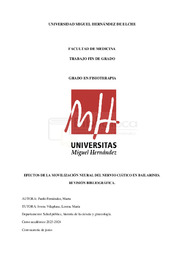Resumen :
Introducción: La práctica de la danza demanda un nivel excepcional de flexibilidad y control neuromuscular para ejecutar movimientos fluidos y expresivos. Los bailarines, suelen incorporar rutinas de estiramientos diarios en su entrenamiento. Sin embargo, la creciente comprensión de los principios neurodinámicos ha destacado la necesidad de complementar estos estiramientos estáticos con técnicas más específicas y dinámicas. Los estiramientos neurodinámicos, no solo promueven la flexibilidad muscular, sino que también optimizan la función del sistema nervioso, mejorando así la calidad del movimiento y reduciendo el riesgo de lesión.
Objetivo: Conocer los efectos de los estiramientos neurodinámicos del nervio ciático en el rango de movimiento de miembro inferior en bailarines.
Metodología: Se ha realizado una búsqueda en las bases de datos Pubmed, Cochrane, PEDro, Scopus, EmBase y Google Académico de ensayos clínicos.
Resultados: Se analizan once artículos. Dada la escasa literatura publicada sobre bailarines se han incluido estudios sobre atletas con síndrome de isquiotibiales cortos, ya que comparten demandas físicas similares con los bailarines en términos de flexibilidad y control muscular. En ellos, se observa como las técnicas neurodinámcias tienen efectos positivos sobre el aumento del rango osteorarticular de movimiento, la flexibilidad de los isquiotibiales, y mejoras en el salto vertical y equilibrio estático.
Conclusiones: Se encuentra evidencia de que las técnicas neurodinámcias tienen efectos positivos sobre el aumento del rango osteoarticular de movimiento de cadera y rodilla. Sin embargo, se necesitan mayor cantidad de estudios y de mayor calidad metodológica.
Introduction: The practice of dance demands an exceptional level of flexibility and neuromuscular control to execute fluid and expressive movements. Dancers often incorporate daily stretching routines into their training. However, the growing understanding of neurodynamic principles has highlighted the need to complement these static stretches with more specific and dynamic techniques. Neurodynamic stretches not only promote muscle flexibility but also optimize nervous system function, thereby improving movement quality and reducing the risk of injury.
Objective: To understand the effects of neurodynamic stretches of the sciatic nerve on the range of motion of the lower limb in dancers.
Methodology: A search was conducted in the PubMed, Cochrane, PEDro, Scopus, EmBase, and Google Scholar databases for clinical trials.
Results: Eleven articles were analyzed. Given the limited literature published on dancers, studies on athletes with short hamstring syndrome were included, as they share similar physical demands with dancers in terms of flexibility and muscle control. These studies show that neurodynamic techniques have positive effects on increasing the osteoarticular range of motion, hamstring flexibility, and improvements in vertical jump and static balance.
Conclusions: There is evidence that neurodynamic techniques positively affect the osteoarticular range of motion of the hip and knee. However, more studies of higher methodological quality are needed.
|
 La licencia se describe como: Atribución-NonComercial-NoDerivada 4.0 Internacional.
La licencia se describe como: Atribución-NonComercial-NoDerivada 4.0 Internacional.
.png)
